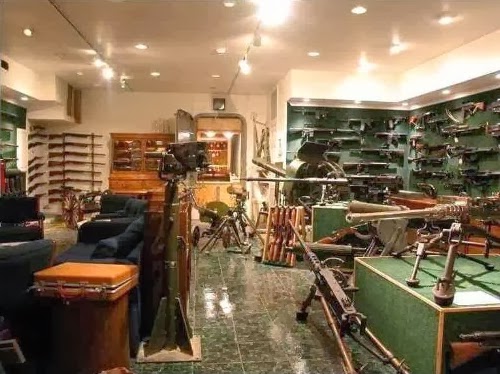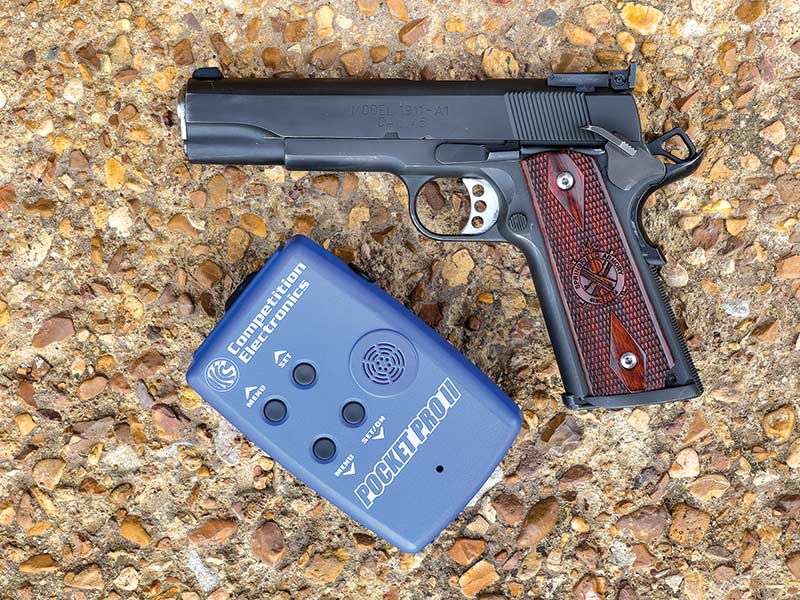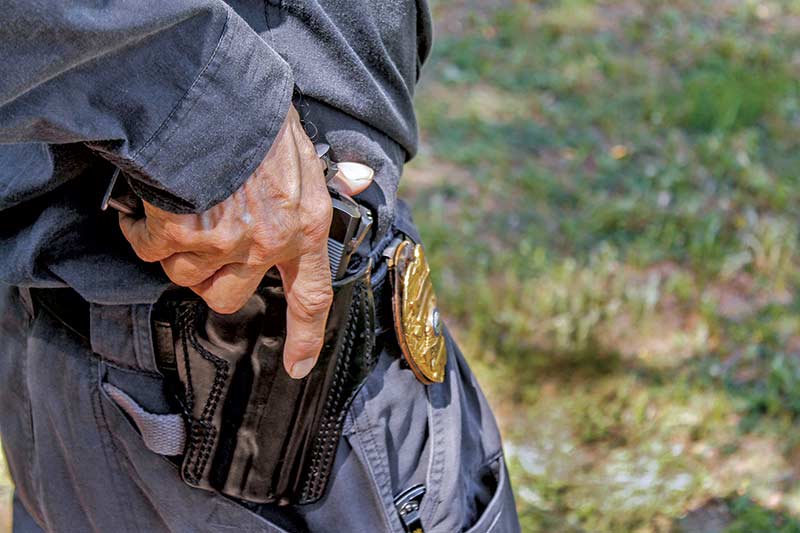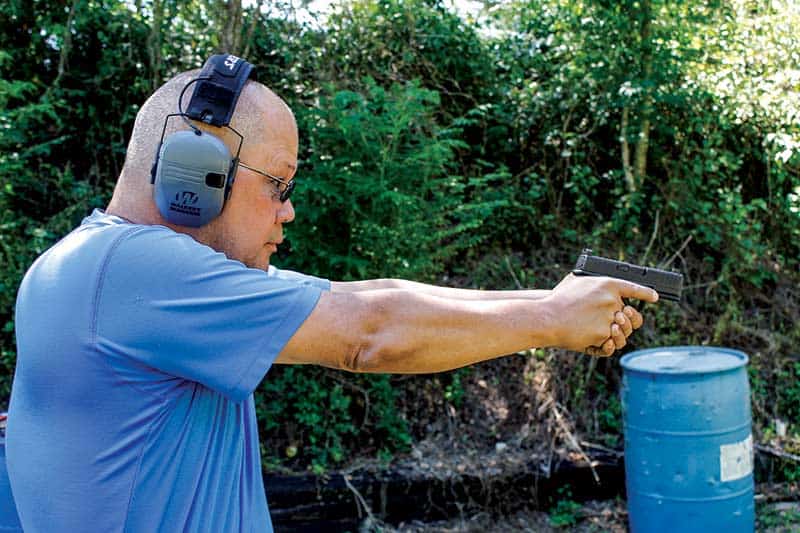Month: August 2023
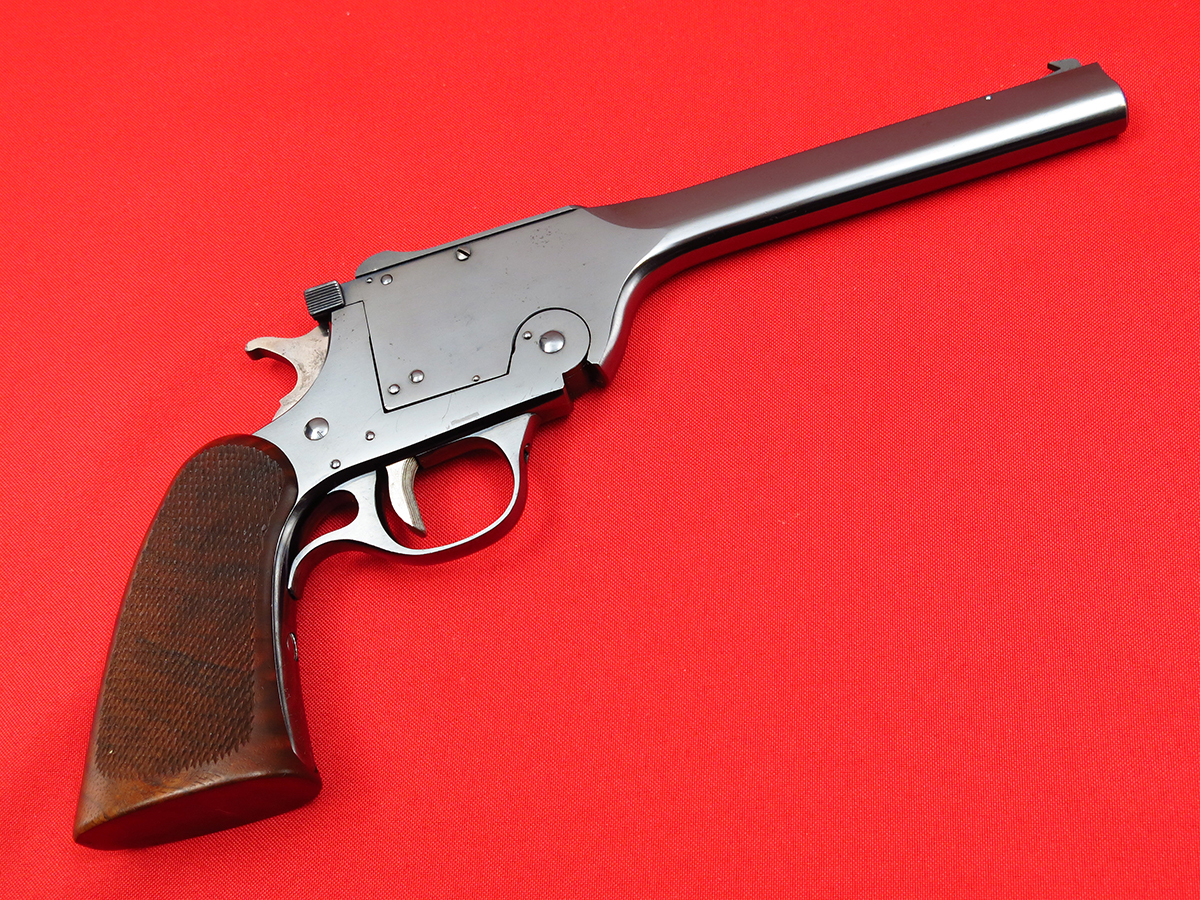

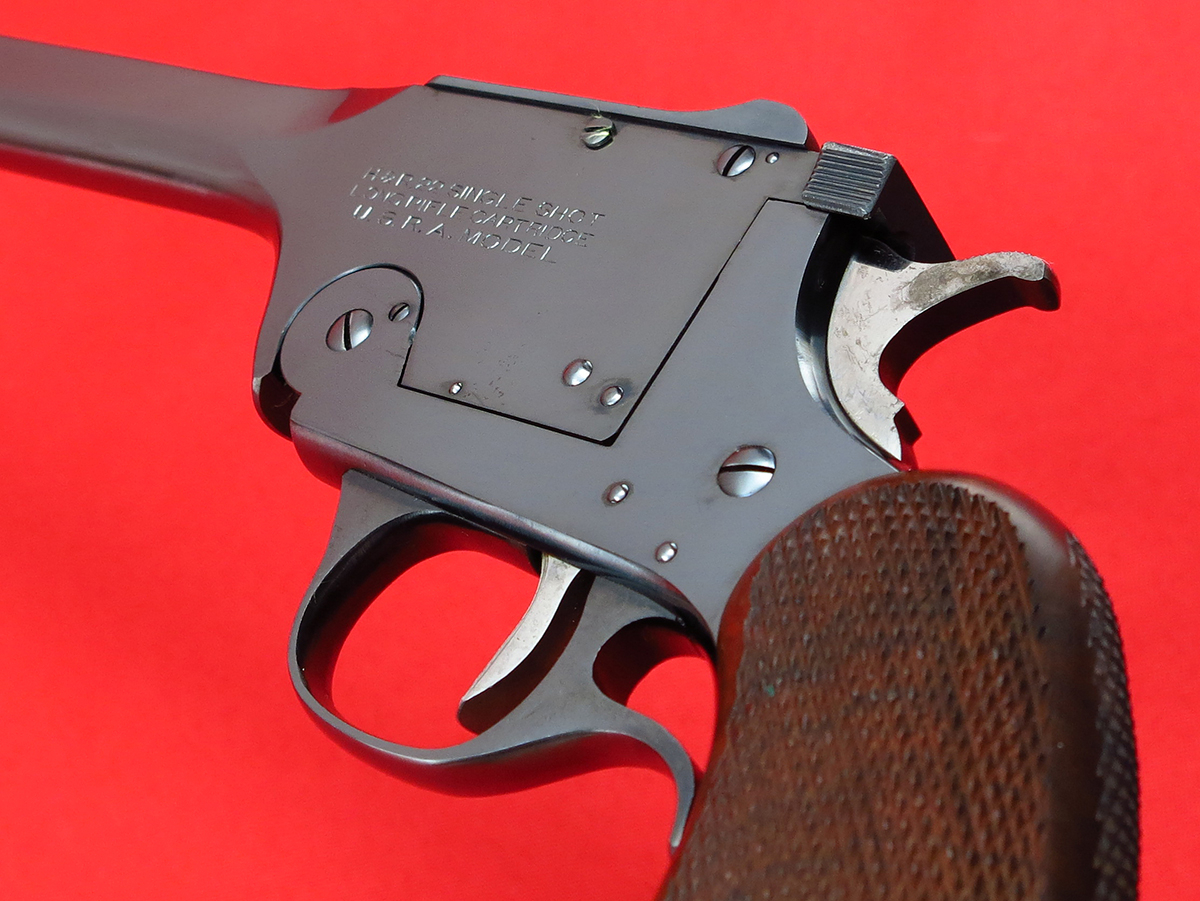

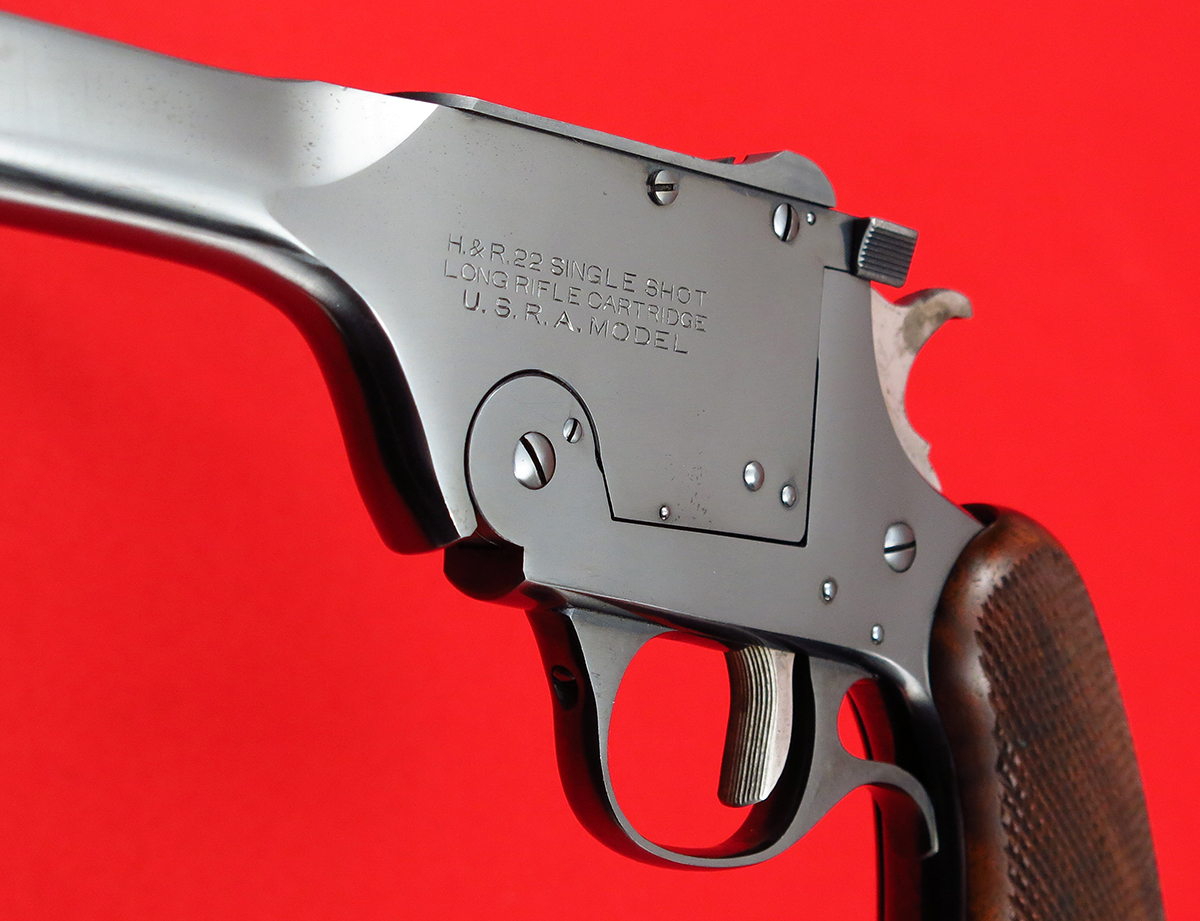

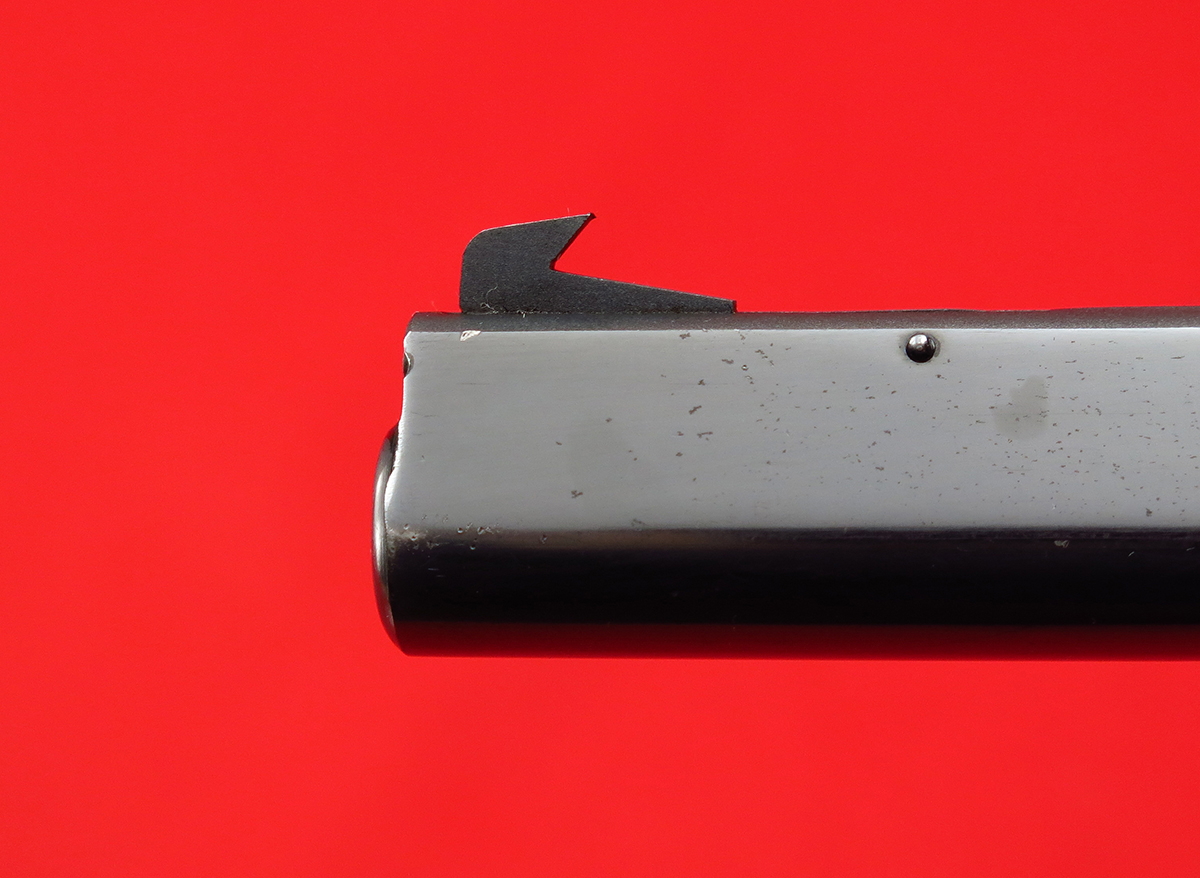
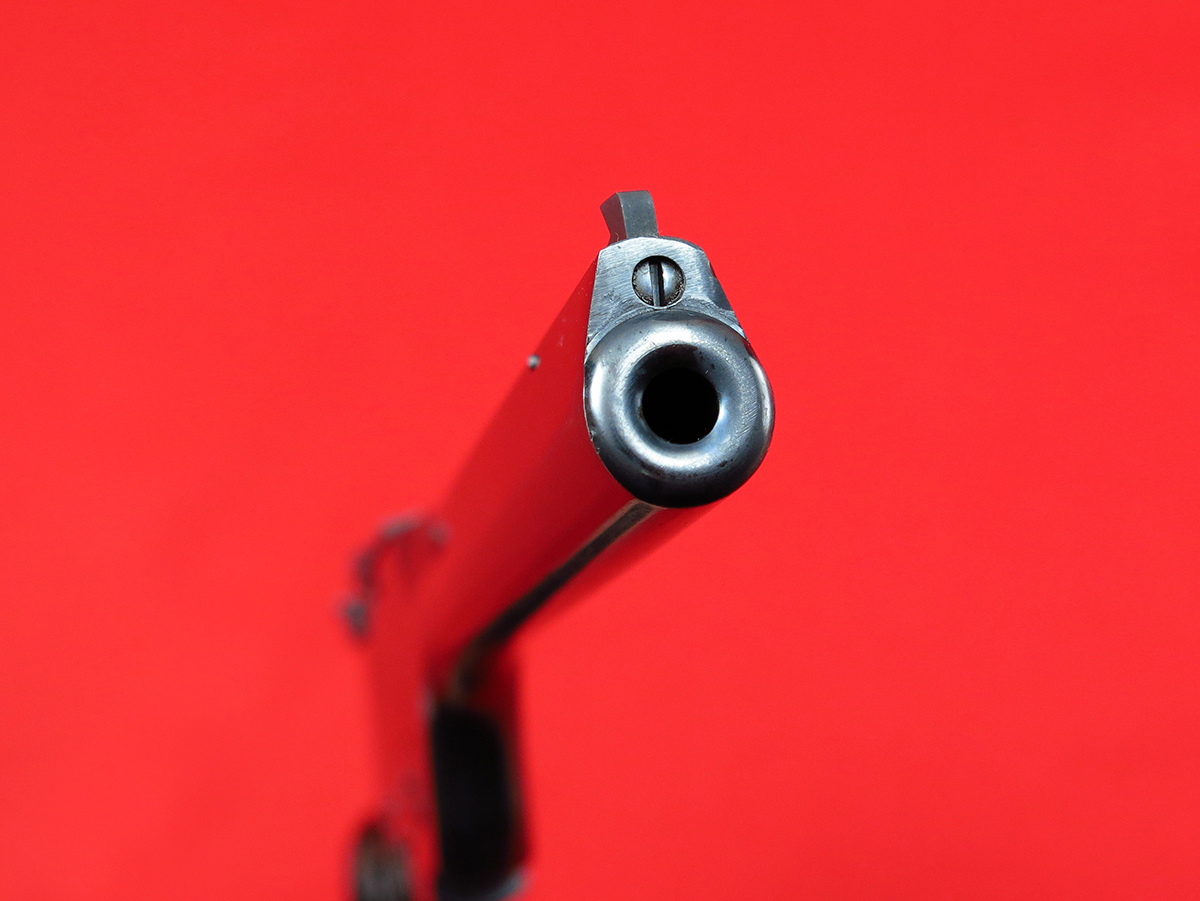
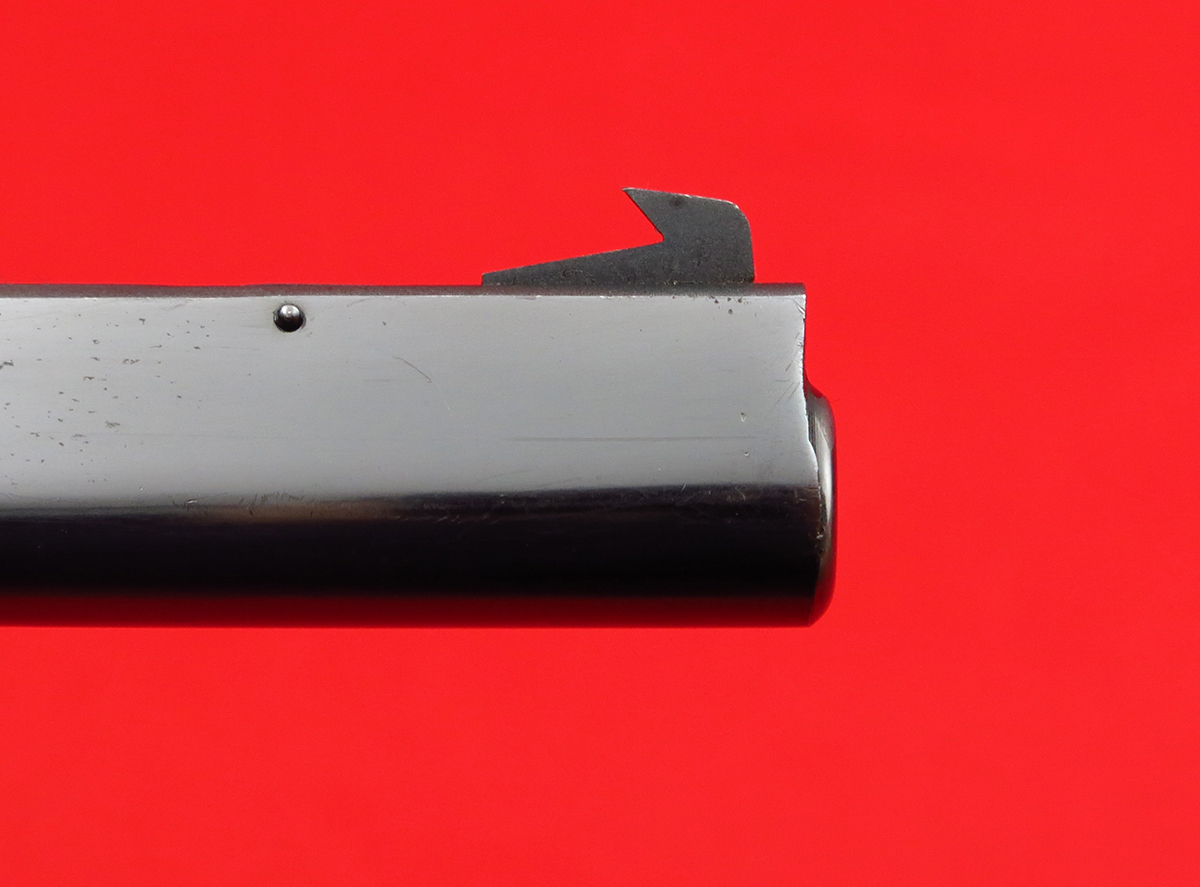
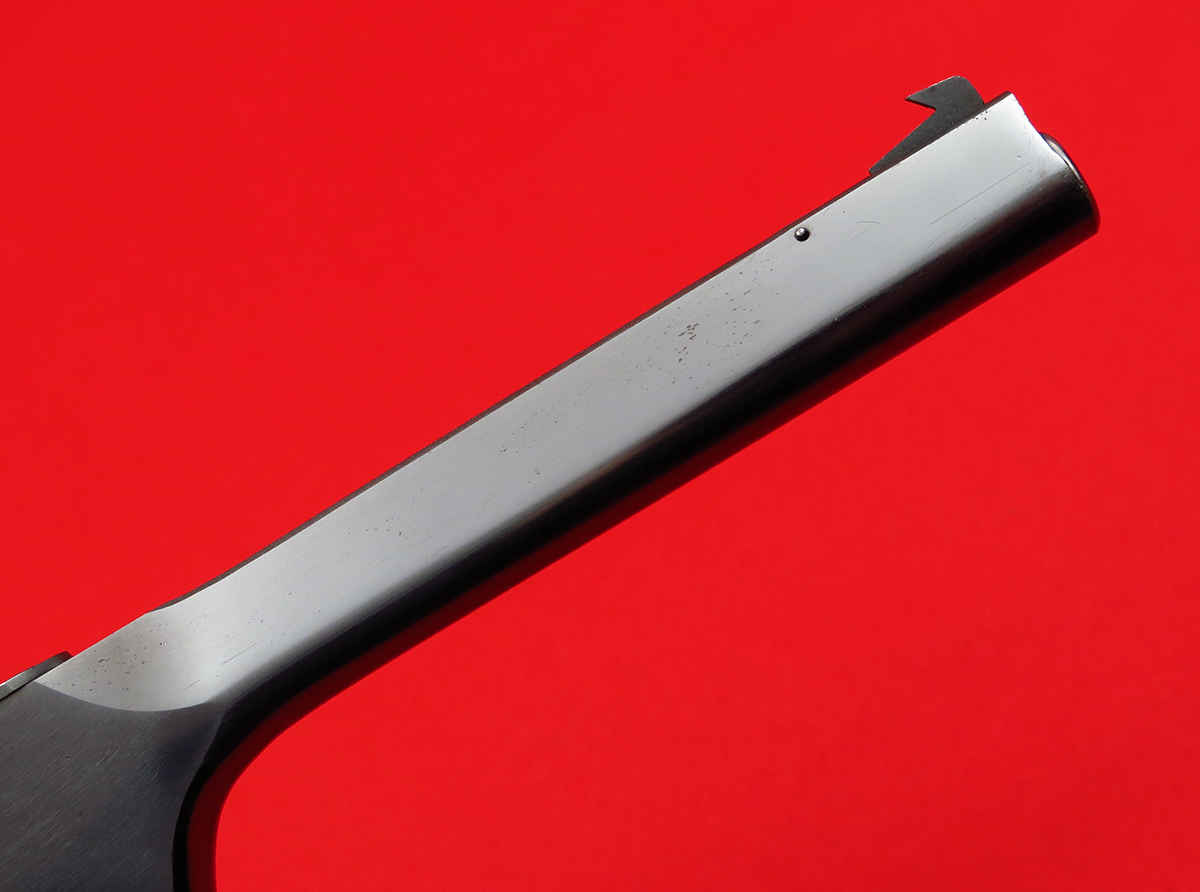
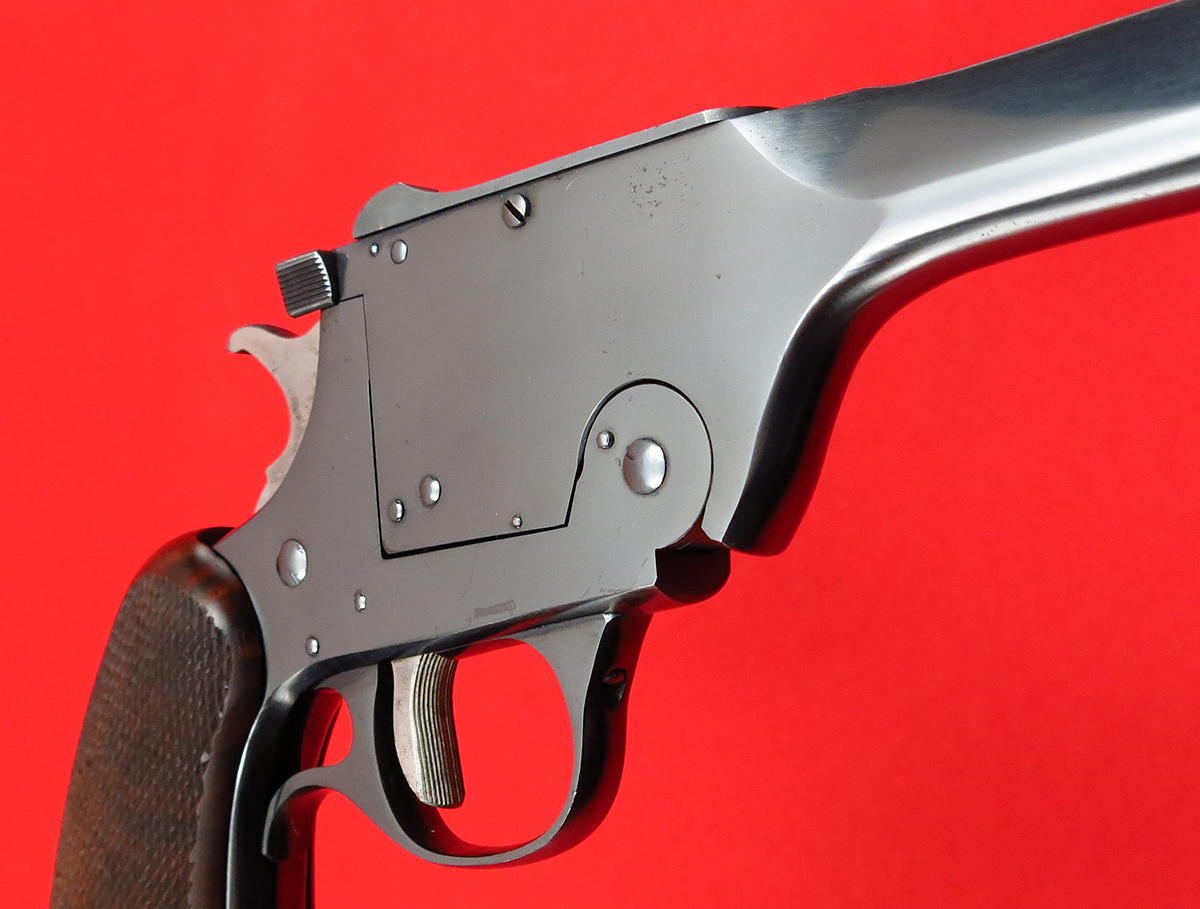
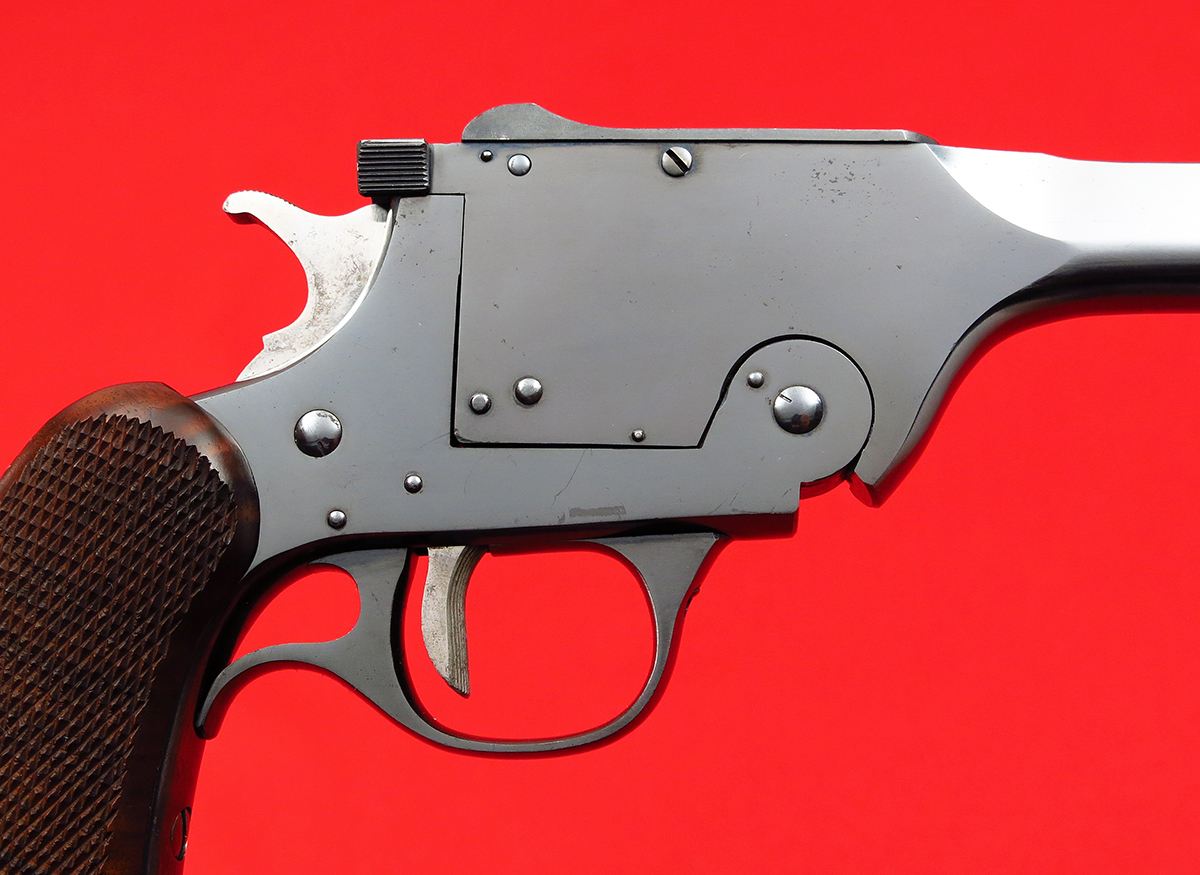
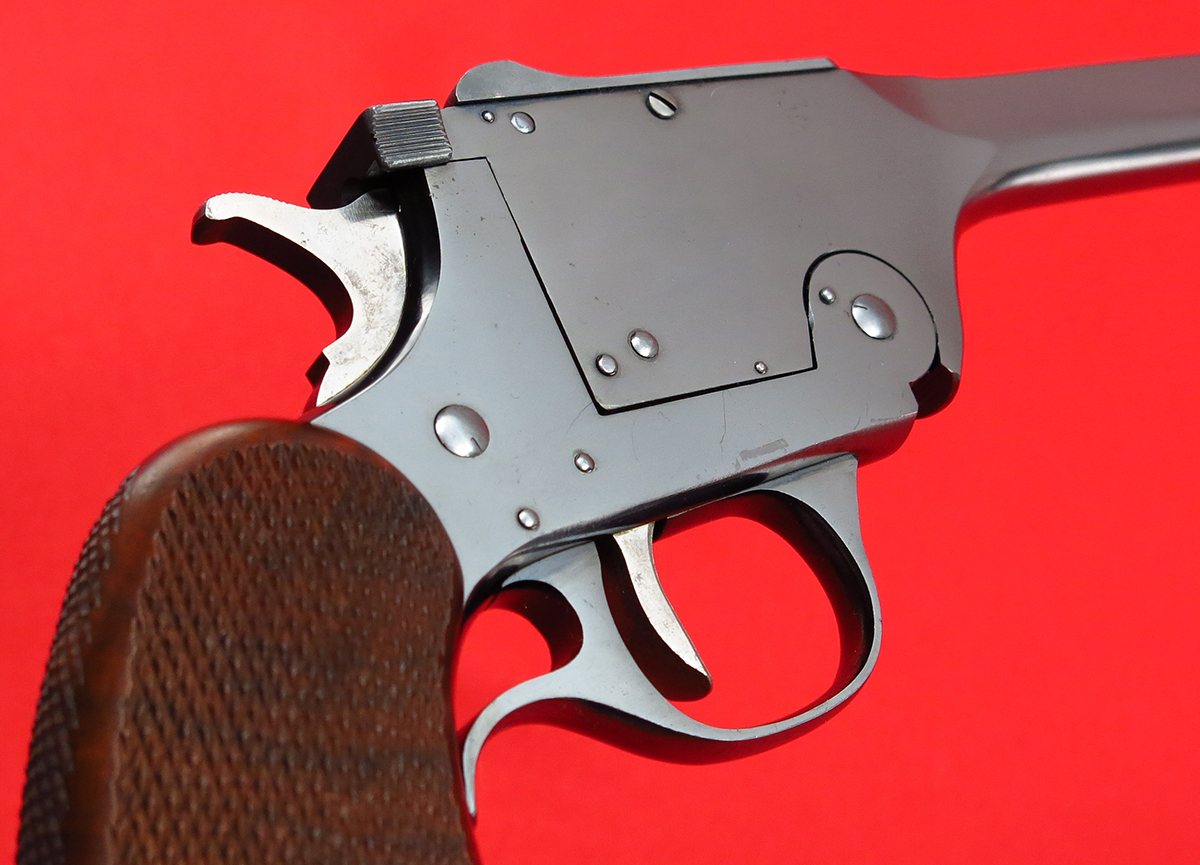
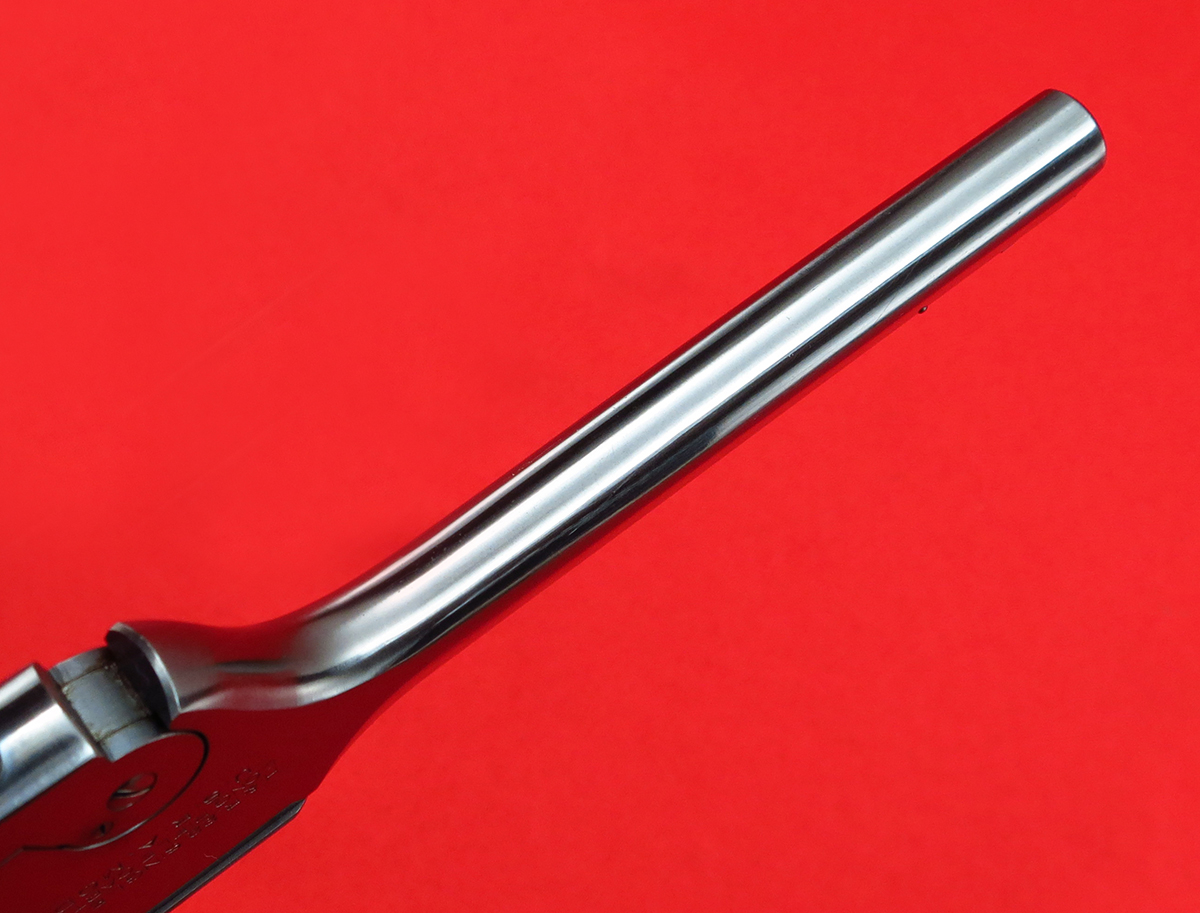
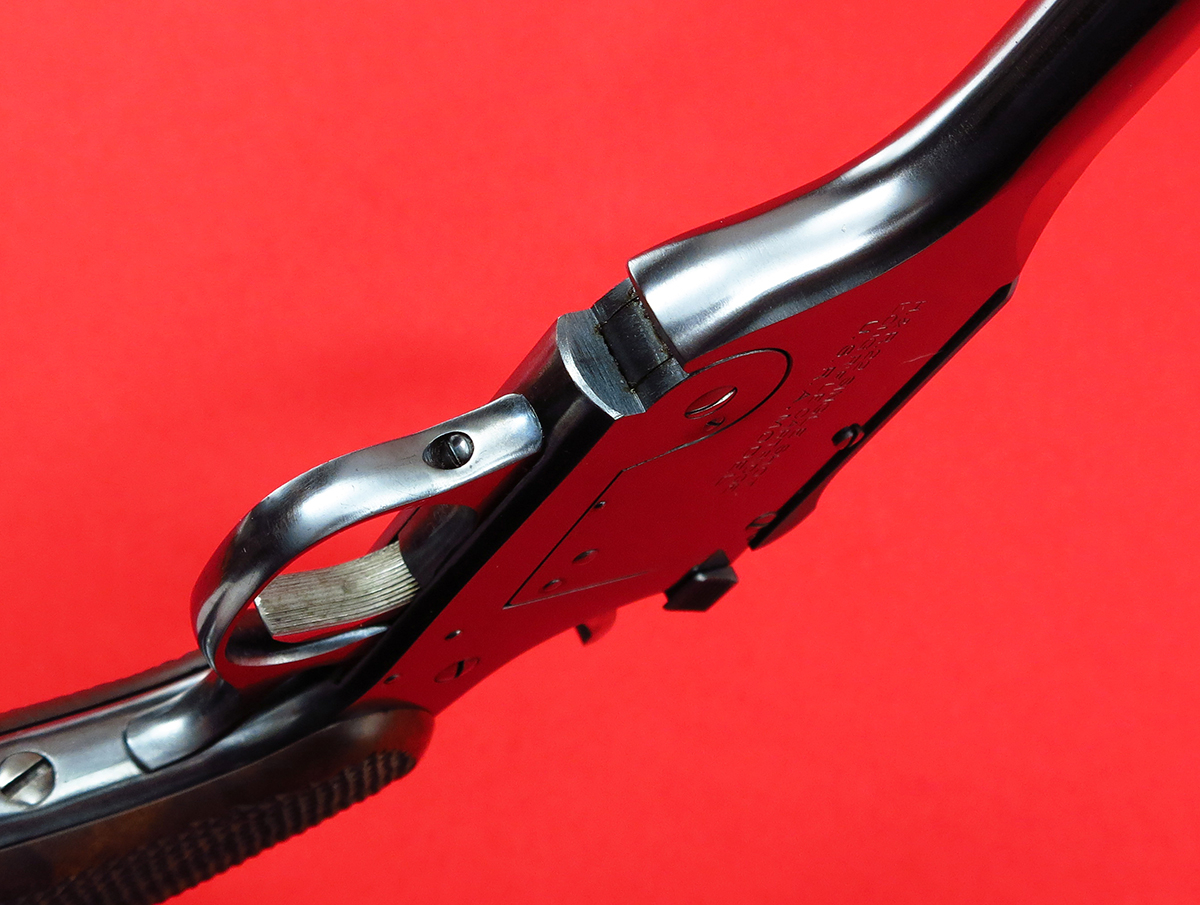
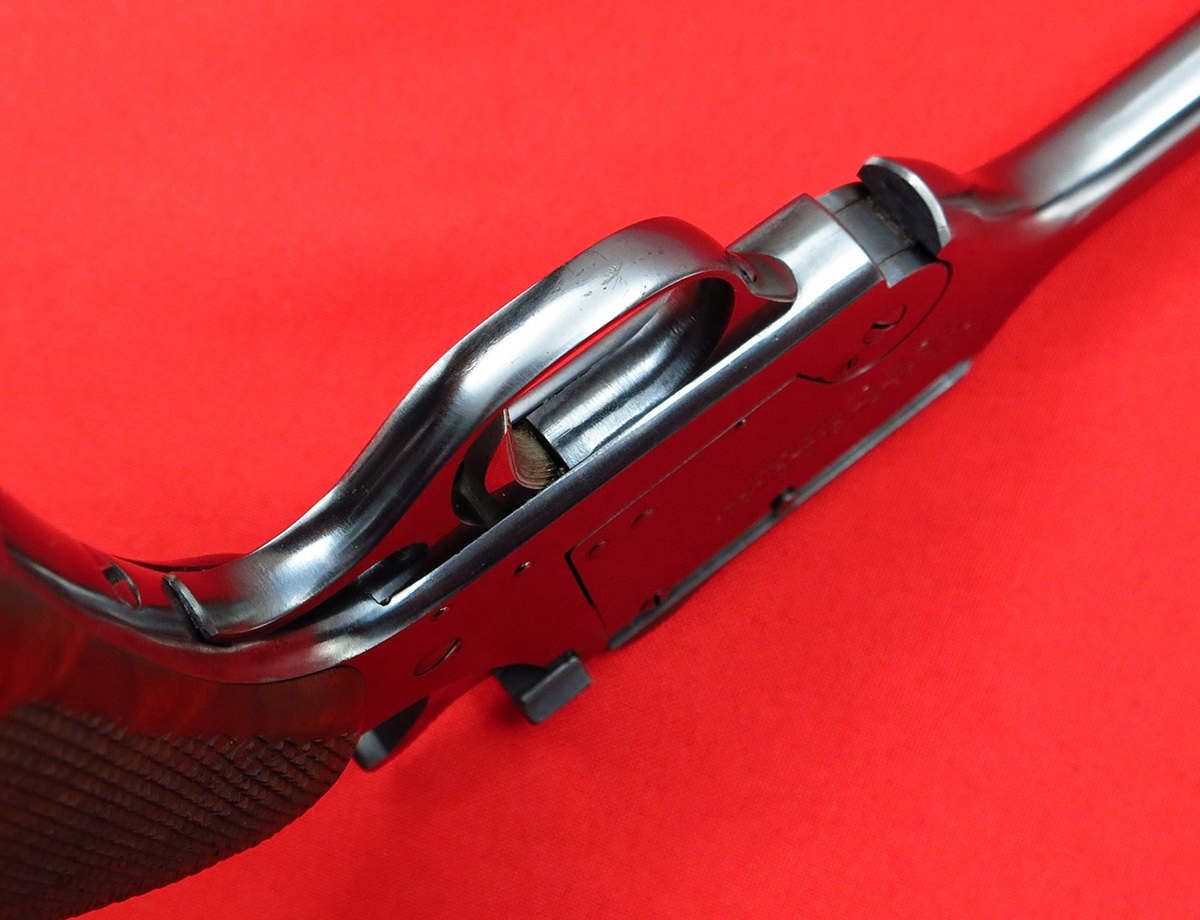
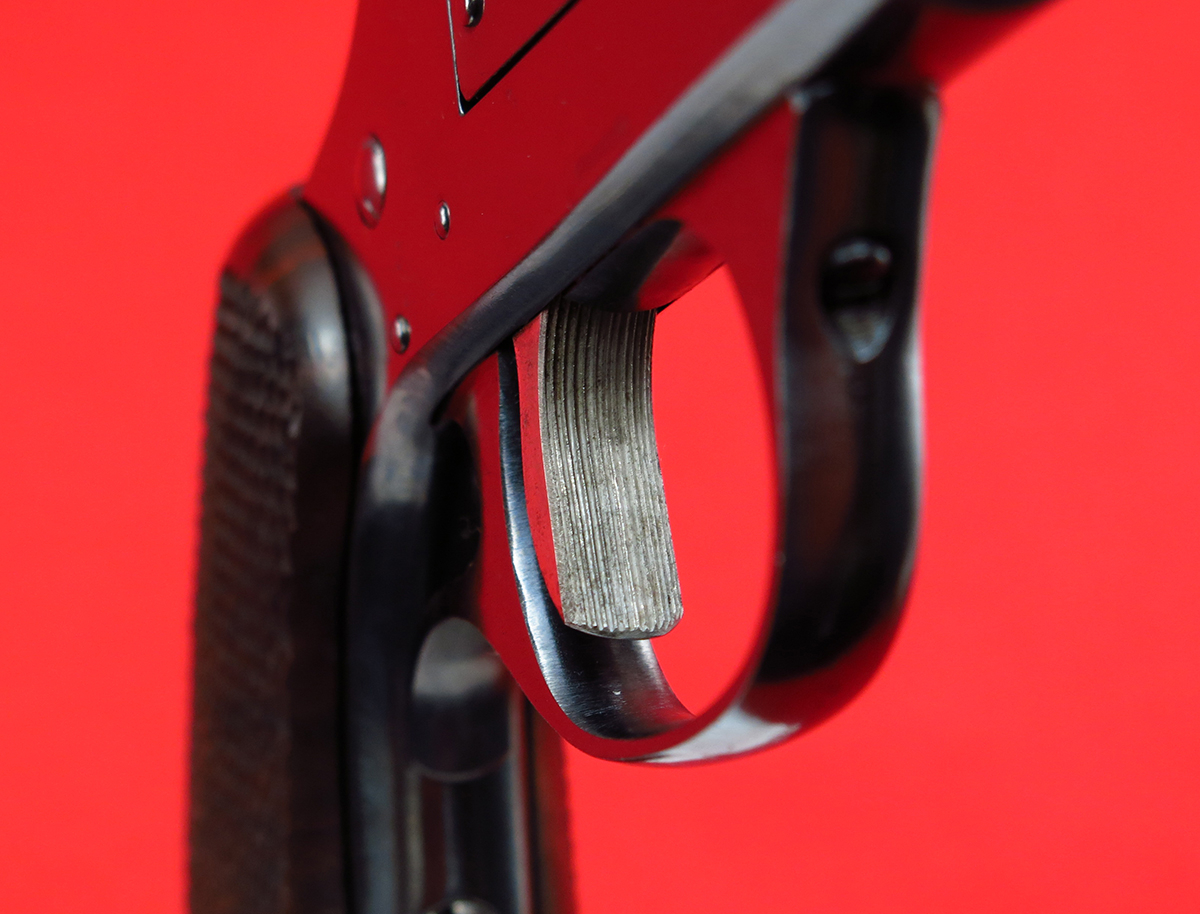

Looks like Big Brother is doing his usual stupid thing again. According to Public Intelligence:
A joint bulletin issued in early August by the Department of Homeland Security and FBI warns state and local law enforcement agencies to look out for people in possession of “large amounts” of weapons and ammunition, describing the discovery of “unusual amounts” of weapons as a potential indicator of criminal or terrorist activity.
Citing the example of Norwegian mass-murderer Anders Behring Breivik, who reportedly “stockpiled approximately 12,000 pounds of precursors, weapons, and armor and hid them underground in remote, wooded locations,” the bulletin instructs law enforcement to look for “large amounts of weapons, ammunition, explosives, accelerants, or explosive precursor chemicals” that “could indicate pre-operational terrorist attack planning or criminal activity.” Weapons do not have to be “cached” in remote locations to meet the standard for suspicious activity. According to the bulletin, weapons could be stored in an “individual’s home, storage facility, or vehicle” and may include common firearms such as “rifles, shotguns, pistols” as well as “military grade weapons.” The illegal possession of large amounts of ammunition is also listed as a potential indicator of “criminal weapons possession related to terrorism.” While the bulletin never clarifies what constitutes a “large” or “unusual” quantity of weapons or ammunition, it does say that such a quantity would “arouse suspicion in a reasonable person.”
There’s more at the link.
The photograph of a ‘weapons cache’ accompanying the article shows a mere five long guns (rifles and shotguns) and seven handguns, for a total of twelve firearms. I could multiply that total a couple of times before running out of the contents of my gun safe, and I don’t have a particularly large collection. Some of my friends could out-do me by an order of magnitude! Consider, for example, these photographs of private – yes, private – gun collections borrowed from this thread on AR15.com (click over there to see many pages of similar pictures – it’s a feast for the eyes of any firearm hobbyist!).
So tell me – are those collections “potential indicator[s] of criminal or terrorist activity”? If not, then my much smaller and lower-quality collection can hardly be considered to be so . . . unless you’re an unthinking, knee-jerk-reacting bureaucrat, I suppose!
As for ammunition – what precisely do they mean by “the illegal possession of large amounts of ammunition”? It’s not illegal to possess ammunition unless you’re a convicted felon – and there are no federal restrictions whatsoever on the quantity of ammunition one may have in one’s possession. (There may be local restrictions such as fire regulations, etc., but these will be area-specific.) To merely say that the quantity would “arouse suspicion in a reasonable person” is ridiculous. For a start, define ‘reasonable’. What does it mean? What’s a reasonable quantity of ammunition to me, as a rifle shooter, might seem alarmingly large to someone who doesn’t shoot at all, or appear ridiculously inadequate to someone who owns one or more machine-guns in the same caliber as my rifle. He might consume a one-year supply of ammunition for me in only a few minutes of firing! Witness last April’s Knob Creek Machine Gun Shoot:
I know a few private individuals who each currently have more than a million rounds of ammunition in their storerooms. (Two of them are friends of mine.) They happen to shoot several hundred thousand rounds per year, so they don’t consider such stocks unreasonable – but the average suburban soccer mom who doesn’t shoot at all would probably have hysterics if she knew they were stored in her neighborhood. (I don’t know why, because it’s no threat to her; but logic usually doesn’t enter into the calculation for such people.)
I try to buy ammunition in case lots – 500 or 1,000 rounds at a time. That quantity will last me for anything from a few months to a few years in the calibers I shoot. I buy it in bulk because it’s cheaper that way. I’m a retired pastor and retired law enforcement officer. Does my buying ammunition in bulk, and possessing a few thousand rounds of it, suddenly render me suspicious to the authorities? If so, I have a few words for them . . . none of them polite!
This is yet another bureaucratic overreach. Perfectly normal activities are now classified as potentially suspicious – and don’t let that word ‘potentially’ fool you. In practice, it means that some law enforcement officers and/or agencies will claim that your possession of large quantities of firearms and/or ammunition is automatically grounds for suspicion, and that you’re therefore automatically to be regarded as a potential terrorist, or criminal, or whatever. Don’t tell me that doesn’t happen. It does. I’ve seen it far too many times before – and the more bureaucratic and unthinking the officer or agency, the more likely it is to happen. Constitutional safeguards are all too often ignored in the process.
It’s long gone time we tossed out of office the politicians who approved the ‘security state’, and dismantled the ‘security bureaucracies’ that do nothing whatsoever to keep us safe – except consume our tax dollars in ever-increasing amounts, and put out such inane ‘alerts’.

At the turn of the 20th century, the bolt action revolutionized the world of affordable .22 rimfire rifles. Winchester was one of the first manufacturers to jump into the low-cost bolt-action .22 market with its John Browning-designed Model 1900. While Winchester’s previous .22 rifles had been based on the company’s lever-action centerfire models, such as the 1873 and 1885, the Model 1900 was a new and simple design. The rear portion of the barrel was machined into a receiver, which accepted the turning bolt. The basic design features of the Model 1900 would carry on for subsequent generations of Winchester single-shot .22 rifles, including one of the most prolific, the Model 67.
By the 1920s, the bolt-action .22 market was crowded, with stiff competition from Savage, Mossberg, Iver Johnson and Remington. Winchester tried several designs in the late ‘20s and ‘30s in an attempt to meet their competitors’ price points before introducing the Model 67 in 1934 in the midst of the Great Depression. In its standard form, the Model 67 featured a 27″ barrel and a walnut stock and had a suggested retail price of $5.50. The rifle would fire .22 Short, Long and Long Rifle cartridges, and a large screw that held the action to the stock allowed for takedown.
With only a few minor design changes, the Model 67 was kept in production until 1963, though manufacture was discontinued between 1942-1945 to allow Winchester to focus on wartime products. Though the total number produced over these three decades is unknown, it is likely in the vicinity of 500,000.
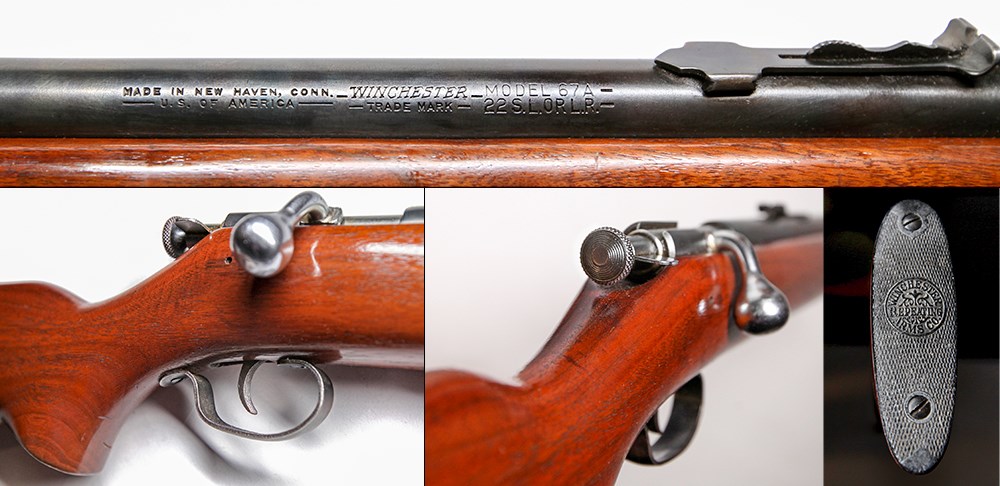
While Model 67s were not serial numbered, there are a few ways to approximately date one. The first year of production has finger grooves in the stock. Starting in 1937, the takedown screw was recessed into the stock. Early post-war rifles used a blued bolt, trigger and cocking piece instead of the normal chrome plating. Numerous other small design changes also give clues as to age. Later improved versions were marked “67A.”
Several notable variants of the Model 67 exist. A .22 WRF chambering was added in 1935, and the following year a smoothbore model was offered for use with .22 shot cartridges. A “Junior” model, introduced in 1937, had a 20″ barrel and a shortened stock. A “Miniature Bore Target” model, with a 24″ barrel and simplified sights designed to shoot small clay pigeons with .22 shot cartridges, was offered in 1940.
While a standard Model 67 could also be ordered from the factory with a Winchester-branded scope mounted, a special version with a scope and no provision for iron sights was called the Model 677 (though it was still marked “Model 67”). Finally, an aperture-sighted “target model” was designated the Model 68. Variants based on the Model 67 would add more than 100,000 units to production totals. Model 67s were also purchased by the British government for training purposes during World War II and can be found with British proofs and military acceptance marks.
The rifle pictured is a standard, post-war Model 67A. It is in NRA Good condition and is valued at $250. Junior Model 67s, along with Model 68s, will bring a 25-percent premium over standard models, and smoothbore models or those chambered in .22 WRF bring a 100-percent premium. With just more than 2,000 of the Model 677s made, it is one of the rarest Winchester .22 single-shots and will command prices of more than $2,000.
Winchester Model 67s and other single-shot, bolt-action .22s of its era would serve generations as everything from a child’s first rifle to a wartime-expedient trainer to a trusty hog killer on butchering day. They are a reminder of a time when American firearm ingenuity offered practicality and affordability in its simplest form.
Gun: Model 67/67A
Manufacturer: Winchester Repeating Arms Co.
Chambering: .22 Short, Long and Long Rifle
Manufactured: c. 1950
Condition: Good (Modern Gun Standards)

A typical Rhodesian service rifle, battered and bruised from the ages. Pictured here with a reproduction chest rig, original side arm and original holster. Photo by Rande Archer
The Fabrique Nationale d’Herstal FAL (Fusil Automatique Léger) was the backbone of the Rhodesian Army during the Bush Wars. Highly regarded by troops for its ease of use, accuracy, quality, and strength, it is also considered one of the most iconic firearms used by the doomed African nation. Today they are highly sought after for their war used pedigree, field applied camouflage aptly named “baby poop,” and ragged looks, fetching prices well above what they were a few years ago. But before we can discuss the current market and affairs with these rifles we should dive briefly into the history of these war horses.

Although an iconic rifle feature, the Rhodesian baby poop was actually left over aviation paint that was used to camouflage the Rhodesian Air Force. Photo by Rande Archer
Back when Rhodesia first became an independent nation, arms embargoes were in place to prevent them from acquiring newer firearms. This led to a situation that forced Rhodesia to pursue alternative ways in acquiring firearms. In addition to their inherited weapons Rhodesia acquired a wide variety of second-hand firearms as well as some Com-bloc items through backdoor deals. Some of the first FALs to be brought into Rhodesia via these shady deals for instance were a large number of ex-German Bundeswehr issue G1 rifles. Often mistaken by collectors as Austrian STG-58s, the markings and serial numbers were all consistent with the serial ranges of G1s sold as surplus by the German government to the Portuguese government and there is no evidence that the Rhodesians ever got their hands on STGs. Other FAL variants that were brought into the country were early FN produced FALs, South African produced R1s, and in some rare instances there were L1A1s of both British and Australian origin in service.

A common feature on most Rhodesian rifles is a holdover from the South African R1s they received: Grenade Sights. Photo by Rande Archer
Once received into service, the Rhodesians marked their weapons with their own serial numbers. These electrostenciled serial numbers with a “RA” prefix help show that the parts were in Rhodesian Army service. The FALs were marked in the following locations: the bolt, the bolt carrier, the upper receiver (not available for sale in the United States due to the ATF ruling that “once a machine gun, always machine gun.” It is not known if a Rhodesian FAL made it on the registry), and the lower receiver. The barrels were not serialized and magazines were marked in a special way, more on that later. It should be noted that after Rhodesia became Zimbabwe the FAL was briefly the standard issue rifle, these were marked in a similar fashion with electrostenciling with a “ZA” prefix instead of “RA.” Most Mugabe era FALs were painted brown and were new-at-the-time purchase Imbels bought directly from Brazil.
Another feature unique to Rhodesian FALs was the act of “sanitizing” their South African R1s. In case of a weapon being captured by the communists and eventually shown to the United Nations as proof of Rhodesia receiving new weapons, the Rhodesians would sanitize their R1s since they were marked with South African factory markings on the lowers and uppers which were a M inside of an U. This sanitizing involved either lightly drilling into where the stamps are, which left a dimple like spot, or they just took a drill and drilled through the whole thing, leaving no trace of the stamp at all on both the upper and lower. This feature is often replicated on reproduction rifles and clones. Another example of sanitizing was found on the new R1 magazines with South African markings, which the Rhodesians would lightly drill or sand them to remove the M in U marking, leaving a dimple or scratched out region. Since the German G1s and Belgian produced FALs were second-hand rifles unlike the minty fresh South African factory rifles, there wasn’t any sanitizing done to them.

Sometimes markings will go untouched due to their odd locations, like this South African factory code, acceptance stamp and date code left intact on a magazine. Photo by Rande Archer
Now the most recognizable and most iconic feature of a Rhodesian FAL is it’s camouflage. However the rifles weren’t always painted like that, the Rhodesians initially painted their rifles black with baked enamel paint, however this led to their soldiers being spotted from afar as long black sticks stood out against camouflage patterns. After a lovely chat with a lad who was captured during a Fireforce operation, the Rhodesians started slapping leftover aviation paint that resembled an angry 6 month old baby’s fecal discharge and some forest green paint on their webbing and rifles so that it would break up their outline. Other features indicative of Rhodesian service was the removal of the carry handle and rear sling swivel from general service. The order to remove carry handles allegedly came after an encounter with insurgents where during the firefight a Rhodesian soldier had the unlucky circumstance of having an ejected brass casing deflect off of his partially extended carry handle and land in his eye, blinding him. A story for the slings was told that they didn’t want the slings getting caught on foliage out in the bush, and it was just easier to remove the slings from general use. However there are many documented cases throughout the war of soldiers using both slings and carry handles.

Although removed from general service, slings and carry handles still saw use in special units such as the Rhodesian Special Air Service, Selous Scouts, and Grey’s Scouts. A popular sling to use for them was the vintage World War Two issue Bren sling, as it was longer than a standard issue sling. Photo by Rande Archer
Now comes the question “Where can I find one of these?” Well, there’s good news and bad news. Good news is there are still parts kits and parts floating around that can be used to build yourself a Rhodesian FAL. Bad news is, they are on the way out. Supply has dried up over the years, as they were briefly imported as kits back in 2003 (for a low price of $150 back then too!). This means prices will be absurd for what they are, rough condition kits with lots of rust and pitting. The best thing to do for this is to keep an eye on Gunbroker (keep an eye out for “South African kit” as these sometimes get listed as South African) for parts kits and parts builds (which pop up sometimes, but most are refinished), and for Armslist for parts builds. The average price for a complete kit has been between 800$ and 1,300$, when they do show up. Add in the price of a receiver of your choice and you’re looking at anywhere between 1,300$ to 1,800$ total for a Rhodesian kit build either built yourself or found online. The degree of difficulty for building one on your own is harder than an AR-15 but easier than an AK. They just require special tools, and a solid vice. Just be sure to keep an out out for those RA serials and you too can one day own a piece of Bush War history.
BROWNING M1910 GUAM WORLD GUN 2012
Situation: A sick man with a bad reputation “gets away with” shooting some people.
Lesson: Deadly force law, in the 19th Century and the 21st, contains elements not widely known then or now by the general public.

Born in Georgia and dying in Colorado, Dr. John Henry Holliday became something between famous and infamous in the 36 years in between. He was a genuine dentist and by all accounts a very good one, but unable to make a living at it because patients didn’t want a man known to have tuberculosis breathing into their faces.
This forced him into a feast-or-famine existence in professional gambling. Said to be skilled at card-counting, and accused of cheating by some, he was known to rake in some substantial pots but by all accounts his overindulgence in alcohol got in the way of sustained profitability. It also doubtless got him into some of the continuous trouble dogging him throughout his short life.
Holliday had contradictory relationships with the criminal justice system. On one hand, some of the most respected lawmen of his day stood up for him publicly: Wyatt Earp, of course, but also Bat Masterson, Pima County (AZ) Sheriff Bob Paul, and Tombstone Chief of Police Virgil Earp who de facto deputized him and armed him with a shotgun on the day of the OK Corral shooting. But on the other hand, Holliday was often arrested, paid many fines, and became intimately familiar with the inside of various jail cells on multiple occasions.
His history as a gunfighter spawned wide-swinging debate among newspapermen in his own time and historians of today. At least one of the latter insists Holliday only killed one man in his life. At the opposite extreme, the Denver Republican said of Holliday in 1882, “The murders committed by him are counted in the scores, and his other crimes are legion.” (1)
Just how skilled at arms was Holliday? Walter Noble Burns, the first author to create the aura of Wyatt Earp as “the lion of Tombstone,” characterized Holliday as an “excellent shot.” Writer Mary Doria Russell was less impressed with Holliday’s marksmanship and hit ratio. She noted, “The mythology isn’t accurate, and neither was Doc! …, I’ve learned from Jeff Guinn’s book The Last Gunfight that Doc participated in a rifle contest while in Tombstone. He ranked very near the bottom of the contestants. My reading of all this is that Doc’s marksmanship was much like my typing skills: we’re quick but not accurate!” (2)
About The Ed Bailey Killing
The legend of Doc Holliday includes the story in Fort Griffin, Texas in 1878, he got into a fight at a gambling table with one Ed Bailey, who Holliday accused of cheating at cards. Bailey supposedly attempted to go for a gun and Holliday drew a large fighting knife from under his coat and stabbed him center mass. One account of the event has Bailey dying from the wound, while in another he survives. We’ll get to a third version momentarily.
The story continues Holliday was taken into custody and fearing a lynching, his girlfriend Katherine “Big Nose Kate” Harony started a fire to divert attention, and then “sprung” Doc at gunpoint, fleeing with him. The tale ends there, with no attempt to arrest and extradite him subsequently.
If the story is true, it’s a testament to poor communications between law enforcement agencies in the American West in the latter 19th Century. However, there seems to be no contemporary records corroborating the account. Respected Western historians and Holliday biographers have expressed doubt it ever happened at all, and both Katherine Harony and Wyatt Earp declared the story to be false during their lifetimes.
Joyce Shooting
The shooting of saloon proprietor Milton Joyce showed the lack of seriousness with which the criminal justice system in Tombstone, Arizona in 1880 treated “shooting scrapes.” The following is from Gary L. Roberts’ excellent book, Doc Holliday: the Life and Legend.
On Sunday evening, October 10, Holliday got into an argument with (John) Tyler near the Oriental (saloon) “which boded a shooting scrape.” Marshal White or Officer James Bennett disarmed both men to defuse the situation and deposited their pistols behind the bar at the Oriental.
“Later, both men returned to the Oriental, where the argument was renewed. Milt Joyce asked Tyler to leave the saloon, ‘as he didn’t want trouble.’ Tyler left, but when Joyce ‘remonstrated with Holliday,’ Doc, who was apparently intoxicated, got into an argument with Joyce during which Joyce ‘bodily fired’ Doc out of the saloon. Doc was no physical match for the burly former blacksmith, who easily threw him into the street. Uncowed, Doc returned and demanded the return of his pistol from behind the bar. Joyce refused to give it to him.
“Infuriated and humiliated, Holliday left again, found another pistol, and returned. He approached Joyce, who was coming out from behind the bar, ‘and with a remark that wouldn’t look well in print, turned loose with a self-cocker.’ Joyce pulled his own pistol and charged Doc, perhaps firing at him once, before using it to knock Doc to the floor with a blow to his head. As they struggled, Marshal White and Officer Bennett arrived and separated them.
In the melee, several shots were fired. Joyce was wounded in the hand, and William Parker was shot in the big toe of his left foot. Gus Williams, a bartender, had fired a shot, which hit no one. Doc was bleeding badly from the blow to his head, and observers thought at the time that he ‘was severely, if not fatally, hurt.’ He was lifted into a chair, and Joyce was escorted out of the saloon. When it was clear Holliday was not critically injured, he was arrested.
“The following day, Fred White secured a warrant against Holliday sworn out by Joyce on a charge of ‘assault with a deadly weapon with intent to kill,’ before Justice of the Peace James Reilly. The next day Doc pleaded guilty to assault and battery even though no witnesses appeared against him in Reilly’s court. He was fined $20 plus $11.25 in court costs.”
Author Roberts considered that getting off lightly, which is an understatement by today’s standards. In today’s America, the tubercular dentist would have died in prison for pleading guilty to that crime.
The OK Corral Aftermath
The most famous gunfight in the history of the Old West took about 30 seconds on October 26, 1881, and is still being debated to this day. We’ve discussed it at length in past Ayoob Files (available online at The Ayoob Files).
For Holliday’s part, it is unquestioned he was the one who shot and killed Tom McLaury. Tom died from a 12-pellet blast of buckshot, and Holliday was the only person at the scene wielding a shotgun, which had been given to him by Virgil Earp. Holliday, alone among the Earp side, was wearing a long “duster” coat that could discreetly conceal the big scatter-gun.
At the end of the fight, it’s pretty much agreed the last man to fall was Tom’s brother Frank McLaury. Frank had been hit in the belly in the beginning seconds of the fight by a slug from Wyatt Earp’s Colt .45. Though the wound had doubled him over, Frank McLaury was still up and running and wielding his own long-barrel Colt single action, a .44-40 Frontier Six-Shooter. Spotting Holliday McLaury shouted at him what would be his last words: “I’ve got you now!”
According to witnesses, the unperturbed Holliday snapped back, “Blaze away! You’re a daisy if you have.”
In the next moment, the famous gunfight came to an end as three men fired virtually simultaneously. Frank McLaury shot Holliday, the bullet skidding off the heavy leather of Doc’s gunbelt, leaving a nasty welt. Holliday returned a revolver shot, and Morgan Earp, who had been downed by a bullet that hit his shoulder and went across his back chipping a vertebra, fired upward from the ground.
Both bullets slammed into McLaury, Holliday’s into the chest and Morgan Earp’s into the head, and McLaury fell heavily into the street. Holliday was heard to cry out, “I’m shot right through. The son of a bitch has shot me and I mean to kill him.” He advanced toward the prostrate McLaury as if to administer a coup de grace, but held his fire when he realized the man was dead and the fight was over.
While we can accept the brain shot by Morgan Earp was the one that decisively downed the last McLaury, Holliday’s shot to the same man’s chest would have been highly likely to be fatal, given the primitive medical care of the time. However, other famous outlaws of the period were known to have survived gunshot wounds to the chest and recovered with little or no medical care. Jesse James and John Wesley Hardin come to mind, and that may be why some historians list the shotgunned Tom McLaury as Holliday’s only “kill” that day.
The shooting polarized the community. The Clanton/McLaury faction was closely tied with county sheriff Johnny Behan, and one of the Tombstone newspapers, along with local Democrats. The Republican Earp faction had the town’s other newspaper on their side. On October 29, warrants were sworn out against Holliday and the three Earp brothers, charging murder. Justice of the Peace Wells Spicer set bail at $10,000 apiece. That $10K in 1881 would have an equivalent value of well over a quarter million dollars today.
Apparently, the justice system in that time and place took it more seriously when three politically connected citizens were killed in the street, than when an angry drunk shot a purveyor of demon rum in the hand.
On November 30, having heard evidence from both sides, JP Spicer ruled that while Virgil Earp taking Holliday with him and giving him the shotgun was “an injudicious and censurable act … I can attach no criminality to his unwise act. In fact, as the result plainly proves, he needed the assistance and support of staunch and true friends, upon whose courage, coolness, and fidelity he could depend, in case of an emergency.”
The prosecution, and some eyewitnesses, maintained Holliday had fired the first shot, but Spicer had accepted Wyatt Earp’s testimony he himself was the one who discharged the very first round, which had struck Frank McLaury. In any case, the Earps, and Holliday, were completely exonerated.
Last Shooting. Last Trial.
In the year 1884, Holliday was living in Leadville, Colorado. Perhaps he thought dry air would ease his tuberculosis, but it appears the wickedly cold winters and thin mountain air would more than offset any such advantage. He had deteriorated to a skeletal 122 lbs. and was described by those who knew him at the time as appearing exceedingly frail.
In Leadville, he had run across many hostile rival gamblers and in particular a nemesis named Billy Allen. Holliday’s gambling luck and his funds had both reached a low ebb, and he found himself owing five dollars to Allen. To the proud dentist’s humiliation, Allen bullied him and threatened him over it.
On one occasion, Allen told him “Holliday, I’ll give you ’til Tuesday to pay this money, and if you don’t pay it, I’ll lick you, you son of a bitch.” Allen told a mutual friend if Holliday didn’t pay him at the appointed time, he “…would knock him down and kick his damned brains out.” Allen told still another party he would “start hunting for him” (Holliday) if the five dollars were not promptly forthcoming. Word of all this reached Holliday’s ears, and he took it seriously.
That day came, and in the afternoon Doc repaired to a bar called Hyman’s. It is believed, knowing it was illegal for him to carry there, he had a friend slip a revolver of Doc’s into a predetermined spot on a shelf near one end of the bar, not far from the door. Holliday stationed himself close to the gun, generally believed to be a double action Colt, probably .41 caliber.
Very shortly, Billy Allen walked in, at least one hand in a pocket as if holding a hidden revolver. Holliday snatched up his Colt and, taking partial cover behind a cigar case, opened fire.
His first shot apparently miss Allen, who either fell or dove to the floor, face down. As he was pushing himself up Holliday fired again, connecting this time. The bullet entered the back of Allen’s upper right arm, cutting an artery. A bystander grabbed Holliday before he could trigger a third shot. Police had been right outside the door, and Holliday surrendered to them readily. No weapon of any kind was recovered from the hemorrhaging Allen.
Charged with “assault with intent to kill,” Holliday languished in jail for months. He would not go to trial for this, his last violent encounter, until March of 1885.
Holliday was promptly acquitted by the jury.
It’s time to look at the “whys.”
Lessons
It was true then and remains true now “allegation” does not necessarily equal “probable cause,” whether or not mainstream media gives false impressions of sensational cases. It’s only hearsay Doc Holliday stabbed someone named Ed Bailey in Fort Griffin.
The legend says Holliday originally fled Georgia because he had murdered some young black people for being in a “whites only” swimming hole. It would have been a heinous felony even in the Deep South in the time of slavery. However, the Holliday family maintained young John Henry had only fired warning shots from a .36-caliber Navy Colt, and some historians can’t even find documentation to support that much.
In the Leadville case, Holliday took the witness stand in his own defense. He explained what he knew of Allen’s promise to harm him if he didn’t pay him the money he didn’t have. A string of witnesses confirmed Allen’s prior threats. There was testimony from one of Allen’s friends Allen had seen Holliday enter the bar and immediately went after him, stating “I am going to hunt this party.” The effect of all this was to establish Holliday was in reasonable fear of death or great bodily harm at Allen’s hands, and the road to this violence had begun with Billy’s previous threats against Doc.
The best analysis of this trial and its outcome I’ve seen comes from the aforementioned Gary L. Roberts in Doc Holliday: The Life and Legend. Here, he quotes Holliday’s testimony at trial: “I knew that I would be a child in his hands if he got hold of me; I weigh 122 lbs.; I think Allen weighs 170 lbs. I have had the pneumonia three or four times; I don’t think I was able to protect myself against him.”
Holliday had just described a principle known today as disparity of force. It comes into play when one’s opponent is not armed with a weapon per se, but has so great a physical advantage over the defender that if the assault continues, it’s likely to cause death or severe injury. Multiple opponents create disparity of force through force of numbers. So can “position of advantage,” where the attacker has the defender in a position where they cannot defend themselves. Ditto known or obviously recognizable high skill in unarmed combat.
In the Holliday/Allen matter, two other elements of disparity of force came into play: distinctly greater physical strength, and the able-bodied attacking the physically disabled. The term “disparity of force” may not have been used in the Holliday trial in Colorado in 1885, but it was certainly an issue in the jury’s deliberations.
Note also the rule of thumb you don’t have to be right, you have to be reasonable. Holliday testified, “I had been told he had a gun and was looking for me; when he came in his right hand was in his pocket; he was about three feet inside the door when I shot; when I shot the first time, he turned and fell; I did not see where his hands were when I shot the second time; I supposed he was going to get there if he could, for I thought he had come there to kill me.”
Holliday obviously testified articulately and believably in Colorado. Why didn’t the defense team put him on the stand in the OK Corral matter? Roberts again has a cogent analysis. “He likely would have been a good witness,” Roberts wrote. “He was bright and savvy enough to have handled himself well on the stand; he could have even submitted a written statement as Wyatt had.
The defense never explained why Doc was not called. Practically, he would have added little to what Wyatt and Virgil had said, but he would have provided the prosecution opportunity to exploit his unsavory reputation and raise questions about his previous brushes with the law in Tombstone. Since the prosecution’s case focused on Doc’s role in precipitating the fight, the defense wisely chose not to put him on the stand. The risks outweighed the advantages.” (3)
Some 135 years later, the reasonableness test applied in both the Tombstone and the Leadville courtrooms remain in effect. So does the disparity of force principle working to Holliday’s advantage in the Leadville trial. The lethal force area is one of the most mature and well-established bodies of law in American jurisprudence. Whether Doc Holliday was a “good guy” or a “bad guy” — or, most likely, a mixture of both — our law holds the evil man has the same rights as the good man.
(1): Denver Republican, May 16, 1882. (2): http://marydoriarussell.net/2011/07/20/docs-marksmanshi/
(3) Roberts, Gary L., Doc Holliday: the Life and Legend, John Wiley & Sons, Inc., 2006, Page 214.
Take a timer to the range and see for yourself, says Mas.
You don’t necessarily have to draw to be in a ready position. Police work being a dangerous profession, cops often have to draw their guns proactively. Some “police reform” advocates are demanding cops write a report every time their pistol clears the holster.
The NC Charlotte Observer reported in 2020, “Charlotte Mecklenburg Police will start tracking every time an officer draws a weapon and points it at someone. The additional reporting is enabled by a new sensor — sometimes called a holster monitor — which automatically turns on an officer’s body-worn camera when a firearm is removed from its holster…. CMPD Chief Johnny Jennings said all officers have now been outfitted with the new ‘signal sidearm’ sensor.
Officers will also be required to report why they drew the weapon and what they did with the weapon after it was drawn — including whether it was pointed at anyone, he said.”
That is over the top. Here are some thoughts on reducing the number of draws and avoiding the onerous process.
Drawn Gun Disadvantages
First, recognize there are many times when a two-hand hold of a drawn duty pistol gets in the way of other things an endangered cop, or, for that matter, an armed citizen, might need to be doing with their hands.
You may have to be manipulating a communications device or illumination device. In the dark, on unfamiliar floors or broken or slippery ground, there is always the possibility of a fall: The result can be a handgun knocked out of battery, its muzzle plugged with snow or mud, or a lost gun. If a situation goes rapidly to “hands-on-suspect,” getting the gun put away quickly becomes an issue. If jumped in the dark, that drawn gun may be the target of a snatch attempt.
“Hand on Gun” Technique
As a young patrolman in the ’70s, I got into the habit of mostly keeping my hand on a holstered weapon with the retaining device released. Jim Lindell taught me handgun retention in Kansas City and I knew “hand on holstered weapon” was the single strongest position for the “Good Guy” when a struggle began.
If you let go of the pistol, today’s uniform duty holsters, such as the Bill Rogers-designed Safariland, will activate the retaining device as soon as your hand leaves the holster. If ready to draw, your thumb will have already deactivated the release mechanism. You only have to worry about the effect on speed and accuracy if you need to shoot.
Speed And Accuracy
How much speed are you losing with the “hand on a holstered gun” instead of already drawn?
I took a timer to the range with my S&W 1911 .45. Starting cocked and locked at low ready from 10 feet, my time to react and fire averaged 0.64 seconds with all center hits. Starting with the hand on the holstered pistol, the average time was 0.916 seconds to react, draw and fire from a two-handed stance. Going for speed, I dropped a few points: 84% hit value as opposed to the 100% from low ready. The time difference had been only a little more than a quarter of a second — 0.276 seconds.
I went to the range with three good friends and repeated the test using Springfield Armory Hellcat Pro striker-fired guns with iron sights from an open-top Kydex. Smarter than me, they went for accuracy instead of speed, and all got 100% hit value from both low ready and starting with “hand on a holstered weapon.”
IDPA Five-Gun Master John Strayer averaged 0.686 seconds from low ready and 1.068 seconds from hand on a holstered gun, an average difference of 0.382 of one second. Retired state investigator Allen Davis averaged 0.564 from low ready and 1.024 from hand on a holstered gun, a difference of 0.46 of one second. The average overall was 0.67 from low ready and 1.178 from hand on a holstered gun — a difference of 0.508 of a second.
If you have an immediate identified threat, you want the gun up and out to start, but for less critical situations, a quarter to a half a second isn’t much of a price to pay for the advantages of “hand on the holstered pistol.”
And in Charlotte-Mecklenberg, you won’t have to write a report, which the cop-haters will use to say you’re gun-happy. Slowing down for the “speed’s fine, accuracy’s final” advice that has stood the test of time from Wyatt Earp to Bill Jordan doesn’t cost you that much.
Try it yourself: What works for you is what’s important. Keep your mind open and your hand full. Having a hand on a holstered gun is the optimum “ready” for some situations.







Gee I am so scared by this! NOT


